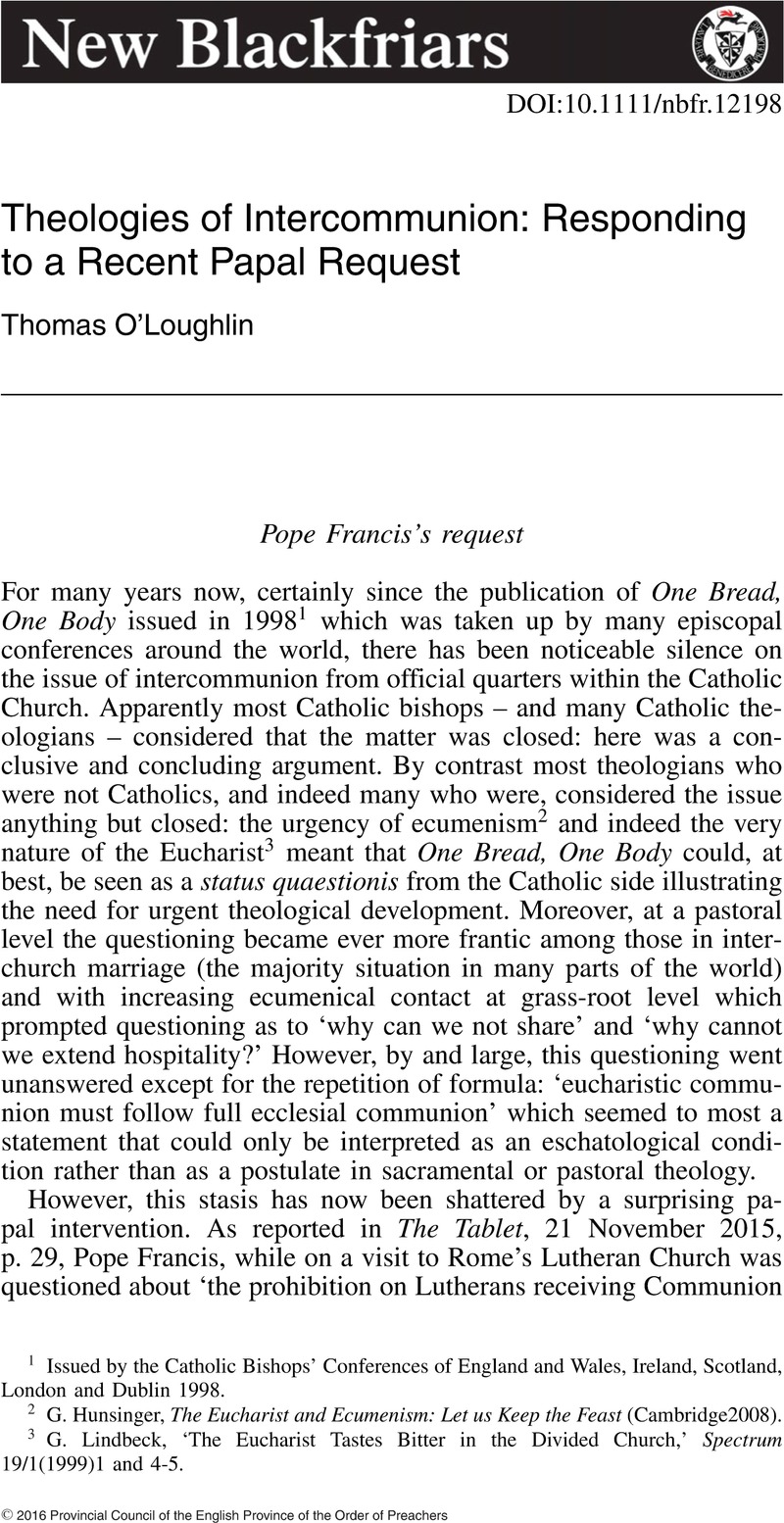No CrossRef data available.
Published online by Cambridge University Press: 01 January 2024

1 Issued by the Catholic Bishops’ Conferences of England and Wales, Ireland, Scotland, London and Dublin 1998.
2 Hunsinger, G., The Eucharist and Ecumenism: Let us Keep the Feast (Cambridge 2008)CrossRefGoogle Scholar.
3 Lindbeck, G., ‘The Eucharist Tastes Bitter in the Divided Church,’ Spectrum 19/1(1999)1 and 4-Google Scholar5.
4 See Smith, D.E., ‘Table Fellowship as a Literary Motif in the Gospel of Luke,’ Journal of Biblical Literature 106(1987)613-38CrossRefGoogle Scholar.
5 See Kobel, E., Dining with John: Communal Meals and Identity Formation in the Fourth Gospel and its Historical and Cultural Context (Leiden 2011)CrossRefGoogle Scholar.
6 Cana was a tiny village, now only ruins, rather than the large town on the modern pilgrim trail; see Hoppe, L.J., ‘Cana of Galilee: The Two Candidates,’ Bible Today 48(2010)161-7Google Scholar.
7 See O'Loughlin, T., ‘Translating Panis in a Eucharistic Context: A Problem of Language and Theology,’ Worship 78(2004)226-35Google Scholar.
8 See O'Loughlin, T., Washing Feet: Imitating the Example of Jesus in the Liturgy Today (Collegeville, MN 2015), 31-52Google Scholar.
9 See O'Loughlin, T., ‘Another post-resurrection meal, and its implications for the early understanding of the Eucharist’ in Rodgers, Z., Daly-Denton, M., and Fitzpatrick-McKinley, A. eds, A Wandering Galilean: Essays in Honour of Seán Freyne (Leiden 2009), 485-503CrossRefGoogle Scholar.
10 See Smith, D.E., From Symposium to Eucharist: The Banquet in the Early Christian World (Minneapolis, MN 2003)Google Scholar.
11 The Instruction, De disciplina circa ieiunium eucharisticum servanda, of 6 January 1953, Acta Apostolicae Sedis 45(1953)47-51.
12 Denzinger-Schönmetzer 812-4.
13 On how such practical matters convey a whole theological position to those who observe them, see O'Loughlin, T., ‘The liturgical vessels of the Latin eucharistic liturgy: a case of an embedded theology,’ Worship 82(2008)482-504Google Scholar.
14 See O'Loughlin, T., ‘Liturgical Evolution and the Fallacy of the Continuing Consequence,’ Worship 83(2009)312-23Google Scholar.
15 Alas there is no modern study of his work or, more importantly, of his methodology, and his Latin is less than pellucid.
16 This solution can be found in Mitchell, N., Cult and Controversy: The Worship of the Eucharist Outside Mass (Collegeville, MN 1982)Google Scholar.
17 The phrase is taken from Summa theologiae 1,1,8, ad 2.
18 See O'Loughlin, T., ‘A liturgy of the Word and the words of the liturgy,’ in O'Loughlin, T. ed., Liturgical Language and Translation (Norwich 2014), 31-8Google Scholar.
19 See O'Loughlin, T., ‘Reactions to the Didache in Early Twentieth-century Britain: A Dispute over the Relationship of History and Doctrine?’ in Brown, S.J, Knight, F., and Morgan-Guy, J., eds Religion, Identity and Conflict in Britain: From the Restoration to the Twentieth Century. Essays in Honour of Keith Robbins (Farnham 2013), 177-94Google Scholar.
20 The Shape of the Liturgy (London 1945), 48, n. 2 – Dix manages to dismiss the whole problem posed by the Didache in a footnote!
21 McGowan, A., Ascetic Eucharists: Food and Drink in Early Christian Ritual Meals (Oxford 1999), 21-2CrossRefGoogle Scholar.
22 See Witherington, B. III, Making a meal of it: rethinking the theology of the Lord's Supper (Waco, TX 2007)Google Scholar; Smith, D.E., and Taussig, H., Many Tables: The Eucharist in the New Testament and Liturgy Today (London 1990)Google Scholar; and Taussig, H., In the Beginning was the Meal: Social Experimentation and Early Christian Identity (Minneapolis, MN 2009)Google Scholar.
23 It is this point, frequently made by anthropologists and those concerned with ‘food security,’ that forms the starting premise for my recent book: The Eucharist: Origins and Contemporary Understandings (London, 2015Google Scholar).
24 Montinari, M., Medieval Tastes: Food, Cooking, and the Table (New York, NY 2012)177Google Scholar.
25 This topic has generated a vast literature which is all too unknown to liturgists, theologians, and pastors: the best place to start is with Visser, M., The Rituals of Dinner: The Origins, Evolution, Eccentricities, and Meaning of Table Manners (London 1993)Google Scholar.
26 See, for example, Ware, K., ‘Church and Eucharist, Communion and Intercommunion, Sobornost 7(1978)550-67Google Scholar.
27 See Jones, M., Feast: Why Humans Share Food (Oxford 2007)Google Scholar.
28 The position that it is not an intimate meal, but simply ‘there’ would indeed imply that the celebration was really no more that a ‘collection point’ for a sacral commodity – the very reason that ‘giving communion’ outside of a celebration of the Eucharist was marginalised in the aftermath of Vatican II. However, since there is eating involved the grammar of meals would once again assert itself and this would render it as not a banquet but ‘fast food’ – an obviously unacceptable view of eucharistic sharing and one of the reasons of the liturgical reforms of the 1960s.
29 See O'Loughlin, T., ‘Sharing Food and Breaking Boundaries: reading of Acts 10-11:18 as a key to Luke's ecumenical agenda in Acts,’ Transformation 32(2015)27-37CrossRefGoogle Scholar.
30 See Giles, R., Re-Pitching the Tent: Re-ordering the church building for worship and mission in the new millennium (Norwich 1996)Google Scholar.
31 See O'Loughlin, T., ‘Eucharistic Celebrations: the Chasm between Idea and Reality,’ New Blackfriars 91(2013)423-38CrossRefGoogle Scholar.
32 See the 1981 General Introduction to the Lectionary, table 2 (Lectionary, vol. 1, p. L).
33 Isa 25:6; and the final line of Aquinas's antiphon for the Magnificat for Evening Prayer for the Feast of Corpus Christi.
34 See Pusey, E.B., The Doctrine of the Real Presence as Contained in the Fathers (Oxford 1855)Google Scholar.
35 See O'Loughlin, T., The Eucharist: Origins and Contemporary Understandings (London 2015), 95-121Google Scholar.